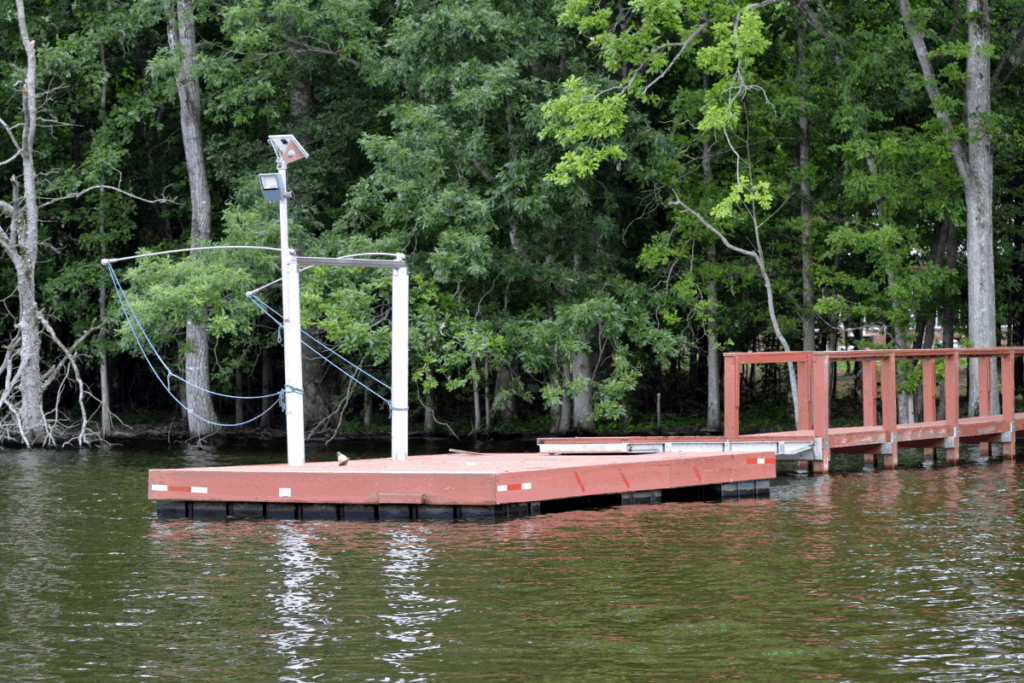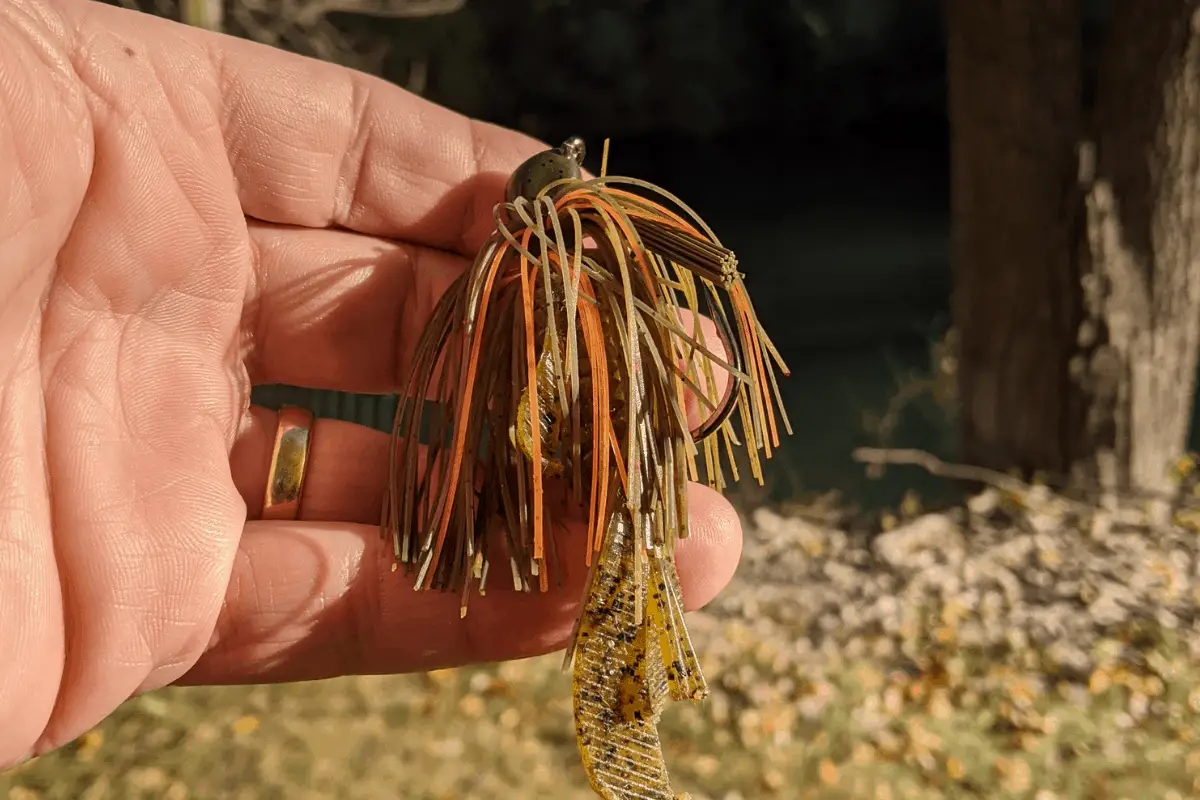Skipping a jig under low-hanging cover is a tremendous way to reach fish that others never even try to catch. It allows anglers to place a lure in places that hold not only lots of fish, but some true lunkers.
When skipping a jig with a baitcaster, it is critical that the reel is setup correctly. First, make sure that both the spool tension and the brake are tighter than you would normally set them. Also, be sure to maintain pressure with your thumb on the spool. Lastly, make sure that you use a rod with either a fast or extra fast tip.
Why Would you Want to Skip a Jig?
Bass love to hide. They are masters at it. Not only because they feel safe, but it offers them the opportunity to ambush unsuspecting prey.
Skipping a jig presents a lure just like it sounds. You skip the bait. The process is much like skipping a flat rock across calm water. When you skip the bait, it allows an angler to present the lure in almost impossible to reach places. Low hanging branches and docks are no longer unreachable.
Bass that hang out in these areas rarely see lures. 9 out of 10 anglers never even attempt to put a bait in those places. Those that do try it often fail in their attempt. That means there is only a small fraction of anglers that are successful in reaching these untouched bass. That in-and-of-itself is enough reason to learn how to skip a jig, yet there is another benefit.
Skipping jigs mimic fleeing baitfish. When minnows are chased by predators, they often skirt and skip across the surface of the water. When this happens, the predatory feeding instinct of bass kick into overdrive.
A skipping jig triggers this same response. Many strikes occur immediately. It is such a fun way to fish.

Why a Baitcast Reel?
Many of you may be wondering, “Why would I use a baitcast reel?” Great question.
It comes down to accuracy. Baitcast reels are much more accurate than using a spinning reel. Now, don’t get me wrong, there are some anglers out there who are really good with a spinning setup as far as accuracy, but putting a lure exactly where you want it is something a baitcast reel excels at. Even though it sounds daunting and backlashes are a pain, you can master this skill and the results will be well worth the time and effort put into it.
The Rod and Reel Setup for Skipping Jigs
As I mentioned earlier, setting up the baitcast reel is critical. I always use a high speed reel in the 7.2:1 gear ratio, but that is not necessary. I just like to quickly reel in my line when the presentation is over.
First, set the brake much tighter than you normally would. The next step is to tighten the spool tension knob. Do not crank it all the way down, but you want to avoid the line from free spooling. When skipping I prefer to go with straight braid. The bait is going to be brought through some nasty stuff. That is exactly what braid is made for. I spool up with 50lb test, but many anglers have their own preferences. You will figure out what works best with the waters you fish most of the time.
The length of the rod is dependent on how tall you are and the distance of your boat deck from the water’s surface. Essentially, you need to find a rod length that allows you to roll cast comfortably. For most anglers, that is going to be a rod that is shorter than what is normally used. I feel very comfortable skipping a jig with a rod in the 7’ to 7’2” range. Trial and error will tell you what is best for your height and boat. Trust me, when you get the right length, you will know it. It just feels perfect.
I prefer a rod with a Medium Heavy action and a fast or very fast taper on it. The soft tip is a critical component to a successful roll cast. The backbone of the medium heavy action rod is quickly engaged by the fast tip. This is crucial to wrestling a bass out from under that heavy cover.
The Lure
The bait that is used for skipping is just as critical for success as the rod and reel. The simplest way I can explain it, is to think back to your rock skipping days. When choosing the perfect skipping rock, you would look for one that has some bulk and an overall flat profile. Do the same thing when selecting a lure.
Some manufacturers do design and market lures that are specifically tailored to this technique. The heads on these jigs have a flat side and are compact, yet bulky. I almost always start with a 1/2oz jig and adjust from there.
When choosing a trailer, the same attention to a bulky, yet flat profile needs to be at the center of the selection process. I normally choose a “creature” style soft plastic that has short appendages to it. As you can see in the photo, this particular bait is very flat. The goal is to pick a jig and trailer combination that creates a flat surface.
I always use some super glue to secure the soft plastic to the jig head. If the jig has a keeper on it – even better. If the trailer slips down the jig during the skip, your entire presentation will be compromised and a backlash is much more likely to occur.
The Cast
The single best advice I can give someone learning to skip jigs, is to keep your eyes on target. Think about it this way, when a baseball player is ready to make a throw. The eyes of the fielder are locked onto their target. The same exact thing needs to happen when skipping a jig. Your hand, arm, rod and reel will take care of themselves. You need to focus on the target you want to hit.
Once you have the target chosen, use a roll cast and fire that lure with your rod tip low to the water. This takes practice. It’s OK to be frustrated, but this is where the mental part of the cast sets in.
You must, and I mean must, commit 100%. Any hesitation at all will result in a failed attempt and a glorious mess will be waiting for you in the middle of your baitcaster.
The Mental Game When Skipping Jigs
To be successful skipping jigs with a baitcaster relies as much on the stuff between your ears as it does the equipment in your hand. I was watching a great video by Mike Iaconelli on this very subject.
To paraphrase, he said that you are going to get backlashes. So what. You can always pick it out after the retrieve.
That single piece of advice changed my entire approach to this effective skill. If you get a backlash on the cast, and you will a lot at first, don’t worry about it. Finish your presentation like normal. After the lure is in the boat you can pull out the backlash.
Many, many, anglers pull out the backlash immediately, and as a result, they often miss a strike.
If you present the lure with confidence and do not hold back in your cast, I promise you, it isn’t that hard to master.
Retrieve and Hook Set
Most strikes will happen right away, but if not, work the cover all the way back. Bang and bump into everything you can.
When you get a bite using this method, the hookset needs to be powerful. This is exactly why a medium heavy action is needed. You want to turn the head of that bass and get it coming to the boat as fast as possible. Otherwise, it will dive deeper into the cover and your odds of winching it out go way down.
A skipping jig will have a stout hook. That, with the combination of the braided line, should give you the confidence to rear back and swing hard on the hook set.
Final Thoughts
Putting time into this technique will separate you from 99% of the anglers that fish your waters. You will get bites that others are never going to get and the possibility of catching a beast of a bucketmouth exists with every cast.
The ability of a baitcast reel to accurately place the lure where you want it makes it the first choice of top anglers across the nation when it comes to skipping.
Questions? Feel free to contact me anytime. Good luck and enjoy the process. It will be worth it.

